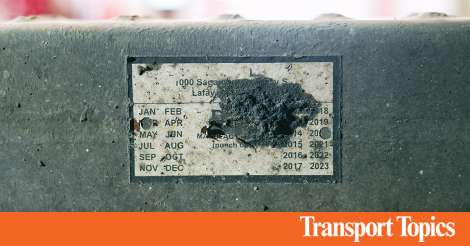Fleets Say Certification Stickers Are Costly and Unnecessary
Through the course of a trailer’s time on the road, labels often are damaged or destroyed by debris and wear and tear. (Nussbaum Transportation)
[Stay on top of transportation news: Get TTNews in your inbox.]
For some time, fleet managers have faced the challenges that come with trailer rear-impact guard certification labels. Although small in physical size, the labels often serve as the difference between compliance or violations that can cause big headaches for fleet leadership.
Through the course of a trailer’s time on the road, the labels often are damaged or destroyed by debris and wear and tear. However, manufacturers have been reluctant or unwilling to replace them, putting fleets in the awkward position of either risking a citation or retiring an otherwise-compliant rear-impact guard.
Their concerns had risen to the point that the Commercial Vehicle Safety Alliance petitioned the Federal Motor Carrier Safety Administration earlier last year to rescind its rule concerning the certification labels. FMSCA denied the petition and, in December, announced its guidance that a missing or incomplete trailer rear-impact guard certification label won’t be considered a violation of a rule requiring one to be affixed.
After FMCSA released its guidance, CVSA’s board voted at its December meeting to re-petition the agency to change the rule, said Kerri Wirachowsky, CVSA’s director of inspection programs.
Wirachowsky said the guidance means fleets should not worry about being charged with a violation.
“As long as this guidance stays on their website, all is well, to be honest, because this guidance is specifically telling enforcement officers from the federal government not to enforce that section,” she said.
FMCSA’s new guidance, which is similar to CVSA’s policy since 2018, says that illegible, incomplete or missing certification labels do not indicate a guard fails to meet National Highway Traffic Safety Administration strength and energy absorption requirements. Instead, it said inspectors should enforce the rule’s general requirements along with requirements for the guard’s width, height, rear surface and the horizontal member’s cross-sectional vertical height.
“FMCSA is also aware that a motor carrier may be unable to replace an illegible, incomplete, or missing certification label,” the guidance stated.
Asked how and why the agency came to its decision, an FMCSA official wrote in an email, “The agency issued the guida…



Comments are closed, but trackbacks and pingbacks are open.